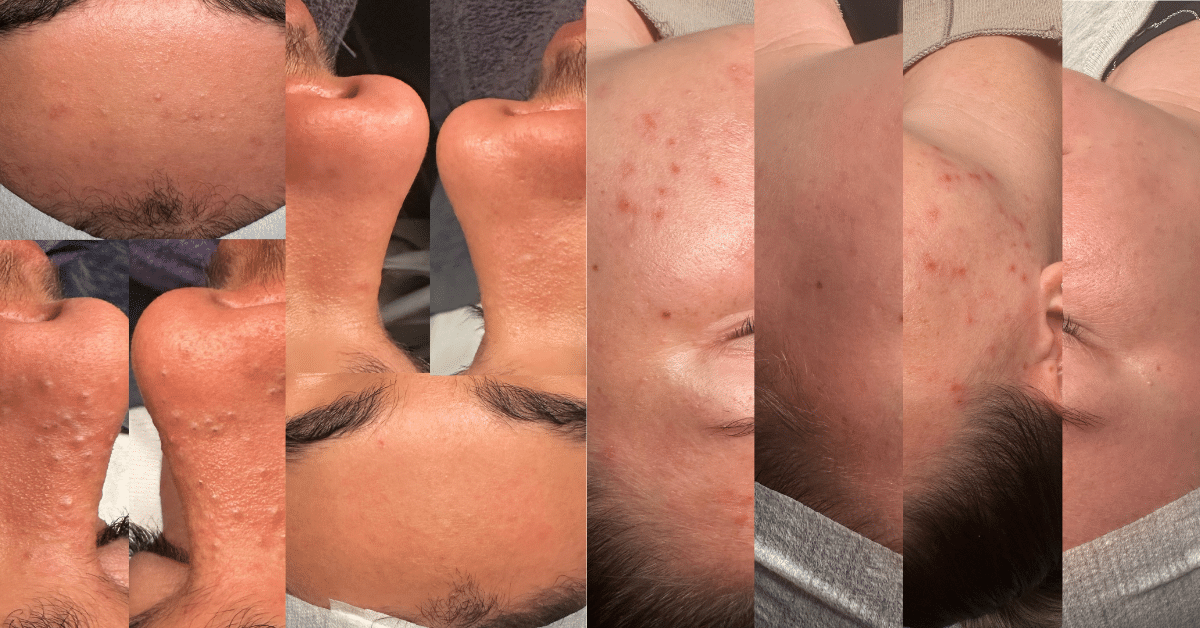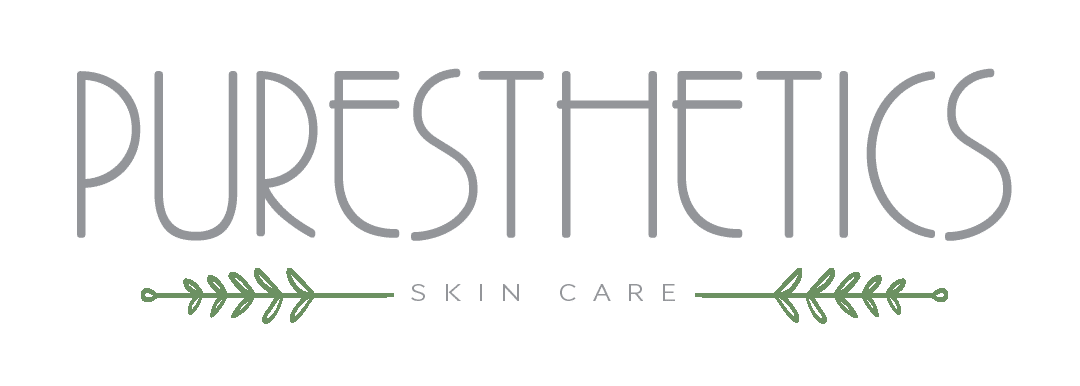
Our Blog

All Things Acne: Types of Acne, Causes and Effective Treatments
Acne is a common skin condition that affects people of all ages, causing both physical and emotional challenges. While it’s often associated with adolescence, acne can persist into adulthood and vary in severity. In this blog post, we’ll delve into what acne is, explore its causes, discuss the different types of acne, and highlight effective treatments to help you better understand and manage this skin concern.
What is Acne?
Acne is a chronic skin condition that occurs when hair follicles become clogged with oil and dead skin cells. This blockage leads to the formation of pimples, blackheads, whiteheads, and deeper lumps known as cysts. Acne most commonly appears on the face, neck, chest, back, and shoulders, where oil glands are more abundant.
Causes of Acne:
- Excess Oil Production: The sebaceous glands, which produce an oily substance called sebum, can become overactive, leading to clogged pores.
- Dead Skin Cells: Normal shedding of dead skin cells can combine with excess oil, contributing to pore blockages.
- Bacteria: The presence of Propionibacterium acnes (P. acnes) bacteria on the skin can exacerbate inflammation within the hair follicles. Propionibacterium acnes is a gram-positive bacterium that is part of the normal flora of human skin, particularly in areas with numerous sebaceous (oil) glands, such as the face, chest, and back. While Propionibacterium Acnes is a normal component of the skin microbiota, it can play a role in the development of acne. The bacterium thrives in hair follicles and feeds on the sebum (oil) produced by sebaceous glands. In individuals prone to acne, an overgrowth of Propionibacterium acnes can contribute to the inflammation and formation of acne lesions.
- Hormonal Changes: Fluctuations in hormone levels, particularly during puberty, menstrual cycles, and pregnancy, can stimulate increased sebum production. Birth Control plays a humongous role in hormonal acne breakouts.
- Genetics: A family history of acne can increase the likelihood of developing the condition.
Types of Acne:
- Whiteheads: Closed plugged pores that bulge beneath the skin’s surface.
- Blackheads: Open plugged pores that have undergone a chemical reaction, causing the clogged material to darken.
- Papules: Small, red, tender bumps without a visible center.
- Pustules: Pimples with a white center, caused by pus accumulation.
- Nodules: Large, painful lumps beneath the skin’s surface, often requiring professional treatment.
- Cysts: Deep, painful, pus-filled lumps that can cause scarring.
How do we treat it?
We specialize in skin like yours and have proven methods to help you clear your skin and keep it under control.
Prescription medications, lifestyle, and food choices can wreak havoc on your entire system, leaving many side effects that linger for years. Don’t waste your time with over-the-counter fads that don’t work, try a proven acne-clearing program that will get you clear in 3-6 months.
We are Certified Acne Specialists with Face Reality Skin Care, a brand made for getting clear and staying clear as well as education on all things acne. With Face Reality products and information, we collaborate with you to achieve your skincare goals. We will track your progress, recommend products, adjust your home care regimen, and perform bi-weekly acne treatments with extractions.
When treating acne, we keep it simple. As professionals, we identify which type of acne or skin condition you are dealing with. Depending on your skin type and acne type, the treatments will consist of different things.
Acne Types:
- Mild, inflamed or non-inflamed
- Moderate, Inflamed or non-inflamed
- Severe, Inflamed or non-inflamed
What does inflamed mean?
When acne is described as “inflamed,” it means that the affected area is experiencing inflammation. Inflammation is a natural response of the body’s immune system to injury, irritation, or infection. In the context of acne, inflammation occurs when the hair follicles become clogged with oil, dead skin cells, and bacteria, leading to various types of pimples and lesions.
Inflamed acne typically manifests as red, swollen, and tender lesions on the skin. The inflammation is a result of the body’s immune response to the presence of bacteria (such as Propionibacterium acnes or P-Acnes Bacteria) and other irritants within the clogged pores. The immune system releases chemicals to combat these invaders, leading to the characteristic redness and swelling associated with inflamed acne.
What does non-inflamed mean?
When acne is described as “non-inflamed,” it refers to lesions or blemishes that do not exhibit significant redness, swelling, or tenderness. The absence of an active inflammatory response in the affected areas typically characterizes non-inflamed acne.
- Whiteheads (Closed Comedones): These are small, flesh-colored, or white bumps on the skin. They occur when a hair follicle is clogged with sebum (oil) and dead skin cells, but the pore remains closed. Since there is no inflammation, whiteheads generally don’t cause redness or swelling.
- Blackheads (Open Comedones): Blackheads are similar to whiteheads, but the pore is open, allowing the trapped material to oxidize and turn dark. Like whiteheads, blackheads are non-inflamed unless a secondary infection occurs.
Non-inflamed acne tends to be less noticeable and often does not cause pain or discomfort. While inflamed acne involves an immune response to the presence of bacteria and other irritants within the clogged pores, non-inflamed acne is primarily a result of the accumulation of sebum and dead skin cells without a significant immune reaction.
Regardless of acne type and severity, the first treatment will always be a gentle hydrating enzyme treatment to begin preparing your skin for AHAs (alpha-hydroxy acids) and other active ingredients like benzoyl peroxide (BHAs). These active ingredients are a huge part of getting clear and staying clear.
The enzyme treatment will gently eat away at the dead skin on the surface and will help lock in moisture due to steam opening up the pores. At the end of the first treatment, we will give you an entire home care regimen for you to follow very strictly, every morning and every night, unless we say otherwise. We also give you many PDFs with tons of info on pore-clogging ingredients in makeup, acne-triggering ingredients in food, birth controls that trigger acne, medications that can interfere with acne clearing, lifestyle choices that can interfere such as irritating laundry detergents, and a cheat sheet on how to use your products properly in the beginning stages.
After the first treatment, we will begin using chemical peels to treat most if not all acne conditions. Our chemical peels are self-neutralizing and have a mix of AHAs and BHAs.
Acne Peel 1 contains
- Mandelic Acid
- Trichloric Acid
- Lactic acid
- Kojic Acid
Acne Peel 2 contains
- Glycerin
- Trichloric Acid
- Mandelic Acid
- Lactic Acid
- Kojic Acid
- Sodium Hyaluronate
- Proline
Acne Peel 3 contains the same ingredients as Peel 2 with a higher trichloric acid concentration.
These peels have specialty ingredients to address hyperpigmentation, inflammation, and fine lines. They gently exfoliate acne-prone, hyperpigmented, and aging skin without excessive irritation or dehydration. It may cause mild to moderate skin flaking depending on the strength used per treatment. We will always modify home care at the end of each treatment to help your skin during the peeling process.
Our regimens usually consist of these main products:
- Wash
- Toner
- Serum
- Acne Med
- Moisturizer
- SPF
Most cases will end up having more than one wash, toner, serum, and moisturizer with different active ingredients in each to target different things. The regimens will also teach you about what your skin needs or wants and how to watch out for what it’s telling you.
Understanding the causes and types of acne is crucial for developing an effective treatment plan. While managing acne can be challenging, various treatments and lifestyle changes can help individuals achieve clearer and healthier skin. If you’re struggling with acne, consulting with a professional is essential to determine the most suitable approach for your specific needs.
Remember, you’re not alone in your journey to clear skin, and there are effective solutions available to help you regain your confidence and promote skin health. If you have any questions, please don’t be afraid to reach out or schedule a consultation. We are here to help! Click here to schedule.

